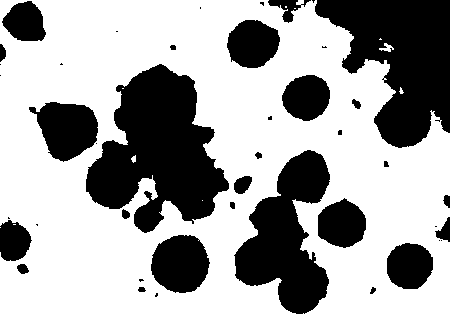Superfine crushing wall-breaking method of haematococcus pluvialis cell
A technology of Haematococcus pluvialis and ultrafine pulverization, applied in the direction of microbial dissolution, etc., can solve the problems of low extraction rate of astaxanthin, achieve the effects of preventing high temperature damage, simple operation process, and high degree of mechanization
- Summary
- Abstract
- Description
- Claims
- Application Information
AI Technical Summary
Problems solved by technology
Method used
Image
Examples
Embodiment 1
[0029] (1) Take out the Haematococcus pluvialis spore powder stored in the dark; freeze-dry it for 2 hours in the dark at -10°C; weigh 200g, add it into the working chamber through the feeding port, and fill it with - Precooling with liquid nitrogen at 197°C for 2 minutes; adjust the flow rate of liquid nitrogen to 0.2m / s, and continuously feed liquid nitrogen;
[0030] (2) Turn on the superfine pulverization equipment at a speed of 26000r / min. After superfine pulverization for 1min, stop the equipment; collect the broken Haematococcus pluvialis spore powder in the cloth bag at the sample outlet.
[0031] Observation by electron microscope showed that the particle size of the treated sample was significantly smaller than that before ultrafine crushing, and a large number of cell wall fragments appeared in the sample. Among them, 78.6% of the cells of Haematococcus pluvialis had cell wall defects; 19.3% of the cells of Haematococcus pluvialls had cracks in the cell walls; the t...
Embodiment 2
[0034] (1) Take out the Haematococcus pluvialis spore powder stored in the dark; freeze-dry it for 2 hours at -15°C in the dark; weigh 200g, add it into the working chamber through the feeding port, and fill it with - Precooling with liquid nitrogen at 197°C for 2 minutes; adjust the flow rate of liquid nitrogen to 0.4m / s, and continuously feed liquid nitrogen;
[0035] (2) Turn on the superfine pulverization equipment at a speed of 26000r / min. After superfine pulverization for 1min, stop the equipment; collect the broken Haematococcus pluvialis spore powder in the cloth bag at the sample outlet.
[0036] Observation by electron microscope showed that the particle size of the treated sample was significantly smaller than that before ultrafine crushing, and a large number of cell wall fragments appeared in the sample. Among them, 84.7% of the cells of Haematococcus pluvialis had defects in their cell walls; 14.1% of the cells of Haematococcus pluvialls had cracks in their cell ...
Embodiment 3
[0039] (1) Take out the Haematococcus pluvialis spore powder stored in the dark; freeze-dry it for 2 hours at -15°C in the dark; weigh 200g, add it into the working chamber through the feeding port, and fill it with - Pre-cooling with liquid nitrogen at 197°C for 2 minutes; adjust the flow rate of liquid nitrogen to 0.4m / s, and continuously feed liquid nitrogen;
[0040] (2) Turn on the superfine pulverization equipment at a speed of 26000r / min. After superfine pulverization for 1min, stop the equipment; collect the broken Haematococcus pluvialis spore powder in the cloth bag at the sample outlet.
[0041] The particle size of the treated sample was significantly smaller than that before ultrafine crushing, and a large number of cell wall fragments appeared in the sample. Among them, 83.3% of the cells of Haematococcus pluvialis had cell wall defects; 15.2% of the cells of Haematococcus pluvialls had cracks in the cell walls; the total broken rate was 98.5%.
[0042] The abso...
PUM
| Property | Measurement | Unit |
|---|---|---|
| absorbance | aaaaa | aaaaa |
| absorbance | aaaaa | aaaaa |
| absorbance | aaaaa | aaaaa |
Abstract
Description
Claims
Application Information
 Login to View More
Login to View More - R&D
- Intellectual Property
- Life Sciences
- Materials
- Tech Scout
- Unparalleled Data Quality
- Higher Quality Content
- 60% Fewer Hallucinations
Browse by: Latest US Patents, China's latest patents, Technical Efficacy Thesaurus, Application Domain, Technology Topic, Popular Technical Reports.
© 2025 PatSnap. All rights reserved.Legal|Privacy policy|Modern Slavery Act Transparency Statement|Sitemap|About US| Contact US: help@patsnap.com


